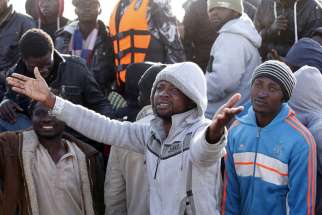VATICAN CITY - Pope Francis joined Austrian church leaders in praying for the 71 refugees found dead in an abandoned truck near Vienna and he condemned the smuggling of migrants as an offense "against the whole human family."
RHODES, Greece - Migrants pay thousands of dollars to human traffickers in countries like Turkey and Libya to ferry them to what they hope are the greener pastures of Europe. The growing crises in places like Libya allow traffickers to work almost unobstructed.
National Geographic story links Philippine priest to ivory smuggling
WASHINGTON - A National Geographic magazine cover story identifies a Philippine Catholic priest accused of sexual abuse in the United States as fueling his country's illegal trade in ivory.
In the course of his research for the October issue, Bryan Christy learned that Msgr. Cristobal Garcia, director of worship for the archdiocese of Cebu, Philippines, had been accused of child sex abuse more than two decades ago but was still serving in priestly ministry.
The article highlights Garcia's extensive ivory religious icon collection and quotes him giving tips on how to smuggle ivory into the Philippines. It also included details of the sexual abuse complaint against him from the 1980s, when he served as a Dominican priest in the archdiocese of Los Angeles. He was expelled from the Dominicans and returned to the Philippines.
In a statement Sept. 26, the Cebu archdiocese said the Vatican had been looking into the sexual abuse complaints against Garcia "long before the (ivory trade) controversy erupted."
"I have also fulfilled the Holy See's instructions regarding submission of documents and acting upon related consequences," Cebu Archbishop Jose Palma said in the statement.
At a news conference the same day, a diocesan official said the Vatican had ordered Garcia suspended from priestly ministry months ago while he is investigated on the charges.
"Let it be made clear that the Church supports the ban on ivory as it is consistent with her doctrine on stewardship of creation," the archbishop's statement said. "The Church does not condone ivory smuggling or other illegal activities, although in the past, ivory was one of the materials used in the adornment of liturgical worship."
The Philippines is a signatory of the international Convention on International Trade of Endangered Species of Wild Fauna and Flora, which means importing ivory to the country is illegal, according to Philippine Bureau of Customs Commissioner Rozzano Rufino Biazon. He explained that anything covered by CITES would have to comply with the country's tariffs and customs code and violations could result in imprisonment of six years.
"And depending on the item that's being imported, applicable laws could bring further penalties to make those longer sentences," said Biazon.
There are also fines, but the bureau's chief of staff of intelligence and investigations, Rainier Ragos, called them "minimal, much less than 100,000 Philippine pesos ($2,400 U.S.)." He said pending legislation in the Philippine congress would impose tougher smuggling fines.
A 2011 Pachyderm Journal article said law enforcement on the ivory trade in the Philippines is "generally poor."
Palma said that religious items made of ivory in the Philippines pre-dated its ban on the trade imposed in 1990.
In the National Geographic article, Christy wrote that the anteroom of Garcia's walled compound is "a mini-museum dominated by large, glass-encased religious figures whose heads and hands are made of ivory: There is an ivory Our Lady of the Rosary holding an ivory Jesus in one, a near-life-size ivory Mother of the Good Shepherd seated beside an ivory Jesus in another. Next to Garcia's desk a solid ivory Christ hangs on a cross."
The article indicates religious practice — Catholic and Buddhist — is a driving force in the desire for ivory.
Christy, who travelled multiple times to Asia for his story, told Catholic News Service in an interview: "In my experience, the devotion to ivory as a religious icon was strongest in the Philippines. In the other places, it was ivory investment even though the image was a religious image, there was ... often a more shallow sort of link, whereas the Filipino collectors that I met truly were devoted."
From 1989 to 2011, more than 40,000 kg of ivory was seized in China, although National Geographic indicated that represents only a fraction of what gets through. The Philippines ranked fifth, at more than 11,000 kg.
The struggle to eradicate ivory smuggling is a deadly one. National Geographic reported that in the first six months of this year, 23 poachers were killed in Kenya. As for casualties on the side of law enforcement in the same time frame, Christy told Catholic News Service that "in Kenya alone a half-dozen (rangers) have been killed, and you can spread that number across Africa. People are killed every year protecting the elephants."




